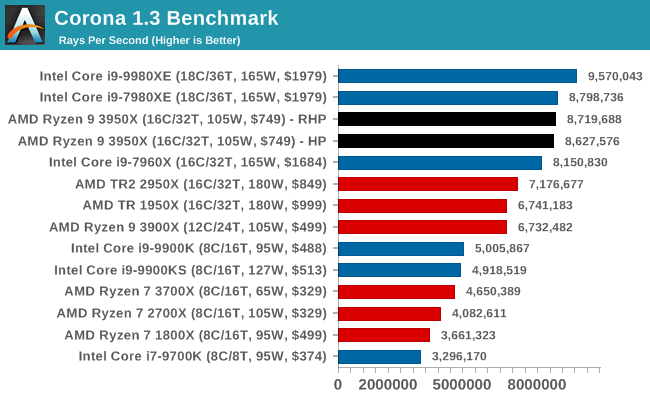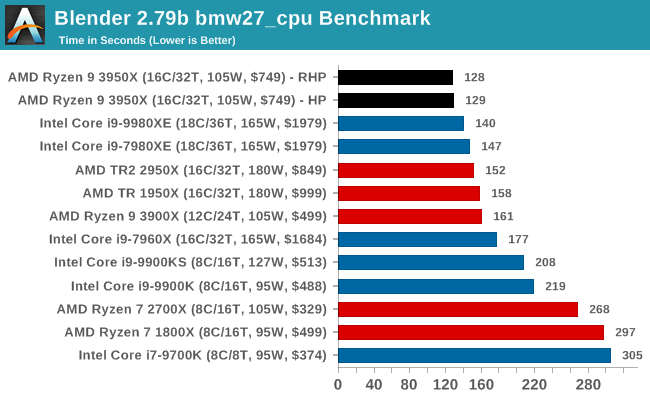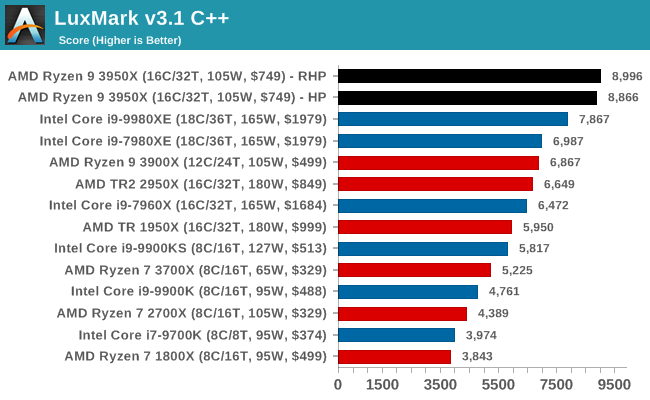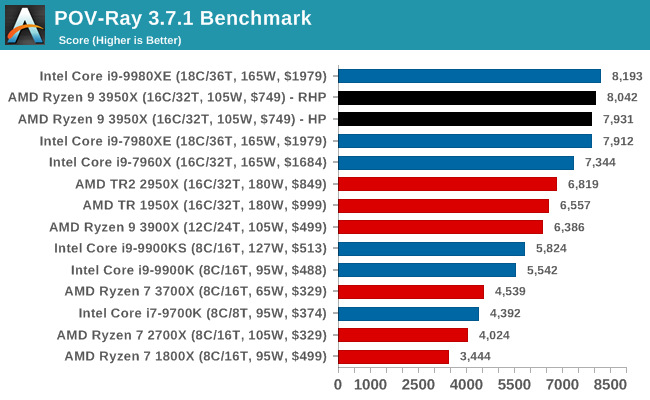The AMD Ryzen 9 3950X Review: 16 Cores on 7nm with PCIe 4.0
by Dr. Ian Cutress on November 14, 2019 9:00 AM ESTCPU Performance: Rendering Tests
Rendering is often a key target for processor workloads, lending itself to a professional environment. It comes in different formats as well, from 3D rendering through rasterization, such as games, or by ray tracing, and invokes the ability of the software to manage meshes, textures, collisions, aliasing, physics (in animations), and discarding unnecessary work. Most renderers offer CPU code paths, while a few use GPUs and select environments use FPGAs or dedicated ASICs. For big studios however, CPUs are still the hardware of choice.
All of our benchmark results can also be found in our benchmark engine, Bench.
Corona 1.3: Performance Render
An advanced performance based renderer for software such as 3ds Max and Cinema 4D, the Corona benchmark renders a generated scene as a standard under its 1.3 software version. Normally the GUI implementation of the benchmark shows the scene being built, and allows the user to upload the result as a ‘time to complete’.
We got in contact with the developer who gave us a command line version of the benchmark that does a direct output of results. Rather than reporting time, we report the average number of rays per second across six runs, as the performance scaling of a result per unit time is typically visually easier to understand.
The Corona benchmark website can be found at https://corona-renderer.com/benchmark

Intel's HEDT chips are quite good at Corona, but if we compare the 3900X to the 3950X, we still see some good scaling.
Blender 2.79b: 3D Creation Suite
A high profile rendering tool, Blender is open-source allowing for massive amounts of configurability, and is used by a number of high-profile animation studios worldwide. The organization recently released a Blender benchmark package, a couple of weeks after we had narrowed our Blender test for our new suite, however their test can take over an hour. For our results, we run one of the sub-tests in that suite through the command line - a standard ‘bmw27’ scene in CPU only mode, and measure the time to complete the render.
Blender can be downloaded at https://www.blender.org/download/

AMD is taking the lead in our blender test, with the 16-core chips easily going through Intel's latest 18-core hardware.
LuxMark v3.1: LuxRender via Different Code Paths
As stated at the top, there are many different ways to process rendering data: CPU, GPU, Accelerator, and others. On top of that, there are many frameworks and APIs in which to program, depending on how the software will be used. LuxMark, a benchmark developed using the LuxRender engine, offers several different scenes and APIs.
In our test, we run the simple ‘Ball’ scene on both the C++ code path, in CPU mode. This scene starts with a rough render and slowly improves the quality over two minutes, giving a final result in what is essentially an average ‘kilorays per second’.

Despite using Intel's Embree engine, again AMD's 16-cores easily win out against Intel's 18-core chips, at under half the cost.
POV-Ray 3.7.1: Ray Tracing
The Persistence of Vision ray tracing engine is another well-known benchmarking tool, which was in a state of relative hibernation until AMD released its Zen processors, to which suddenly both Intel and AMD were submitting code to the main branch of the open source project. For our test, we use the built-in benchmark for all-cores, called from the command line.
POV-Ray can be downloaded from http://www.povray.org/

POV-Ray ends up with AMD 16-core splitting the two Intel 18-core parts, which means we're likely to see the Intel Core i9-10980XE at the top here. It would have been interesting to see where an Intel 16-core Core-X on Cascade would end up for a direct comparison, but Intel has no new 16-core chip planned.











206 Comments
View All Comments
529th - Thursday, November 14, 2019 - link
There is also a Windows power plan called 'Ultimate' What's better for AMD Ryzen CPUs, RHP or the plain old Windows Ultimate power plan?TallestJon96 - Thursday, November 14, 2019 - link
Stop testing with a GTX 1080. It is almost 4 years old, and there are half a dozen cards that are significantly faster than it now. Anandtech's gaming benchmarks are behind the times and not very useful because of this.Hadenas - Thursday, November 14, 2019 - link
Please start using either a 2080 or 2080ti for gaming test. Nobody would use a 1080 with the 3950x.Satyyri1972 - Wednesday, November 20, 2019 - link
I amCHADBOGA - Thursday, November 14, 2019 - link
Always wonderful to see the worst gaming setup for benchmarking, anywhere on the internet.SanX - Friday, November 15, 2019 - link
where is source code for 3D particle movement? In the link above are only exe files and it is unclear what the test is doing. May be it is doing just one single operation in cache over and over again.lenghui - Friday, November 15, 2019 - link
I am guilty of not reading the entire article, and will definitely come back again to read it all. At a glance, I love how AnandTech includes the prices so that I don't have to keep looking it up. However, I am still unable to figure out what RHP vs HP means half way through the charts. I wish there is a simple legend to explain that. I tried looking around and didn't find any references. Again, I am guilty of not reading it all, just saying it would be super convenient when I want to look at the results in a crunch.lenghui - Friday, November 15, 2019 - link
Thanks for the review, Ian. I finally got to the last page and saw what HP and RHP means, but my earlier comment still stand.To me personally, I never ran Ryzen Master since the first two days I built my Ryzen machine because Ryzen Master can only launch when Virtualization Based Security (VBS) is disabled. This is really lame on AMD part. I built this 8 core-16 thread machine to run my VMs, but I can't run Ryzen Master :( Other than that, I love my build.
GreenReaper - Friday, November 15, 2019 - link
This piece is a great endorsement of the 3900X, or the 3700X for desktop tasks. Why pay more?You profit from being willing to accept imperfect cores - and let's not forget a cooler is thrown in.
Testing for the latest issues will be fun; not only do you have before/after microcode patches, you have before/after the program under testing was recompiled to avoid the situation requiring patching.
Sailor23M - Friday, November 15, 2019 - link
3700X missing in the price/perf graph.